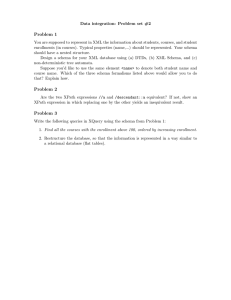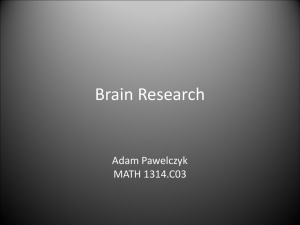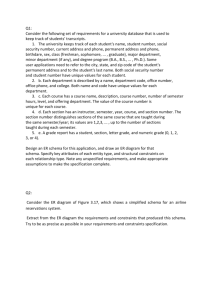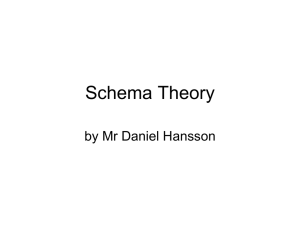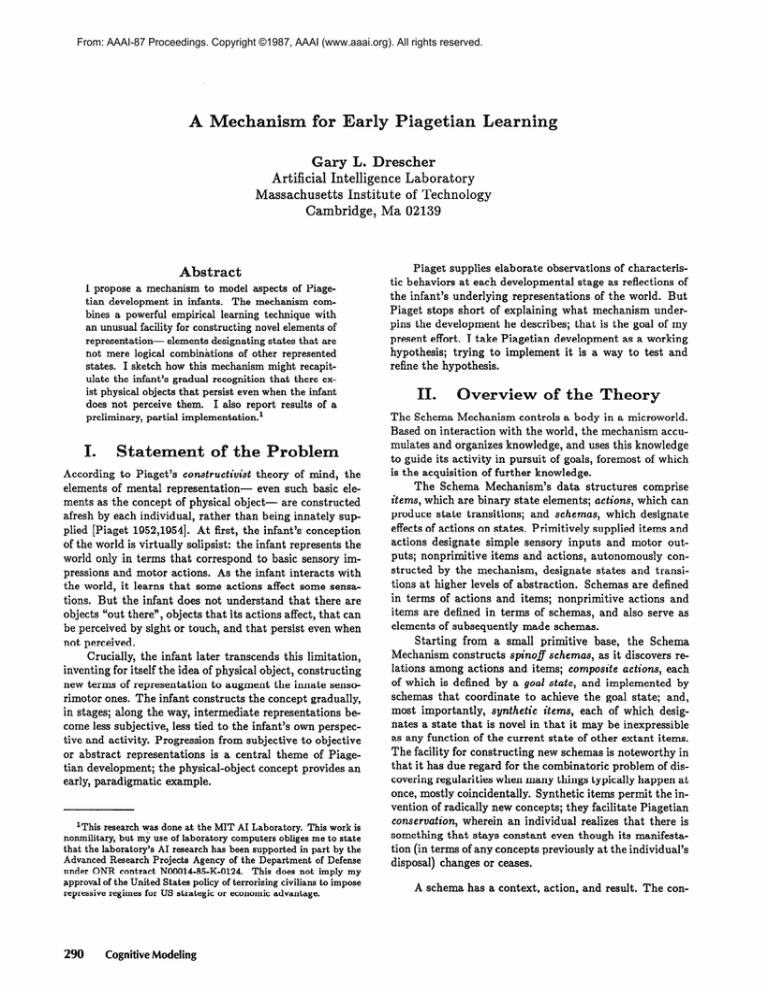
From: AAAI-87 Proceedings. Copyright ©1987, AAAI (www.aaai.org). All rights reserved.
A Mechanism
for Early
iagetian
Learning
Gary L. Drescher
Artificial Intelligence Laboratory
Massachusetts Institute of Technology
Cambridge, Ma 02139
Abstract
I propose a mechanism to model aspects of Piagetian development, in infants. The mechanism combines a powerful empirical learning technique with
an unusual facility for constructing novel elements of
representation- elements designating states that are
not, mere logical combin&ions of other represented
states. I sketch how this mechanism might recapitulate the infant’s gradual recognition that there exist physical objects that persist even when the infant
does not perceive them. I also report results of a
preliminary, partial implementati0n.l
I.
Statement
Piaget supplies elaborate observations of characteristic behaviors at each developmental stage as reflections of
the infant’s underlying representations of the world. But,
Piaget stops short of explaining what mechanism underpins the development he describes; that is the goal of my
present effort. I take Piagetian development as a working
hypothesis; trying to implement it is a way to test and
refine the hypothesis.
of the
According to Piaget’s constrzlctiuist theory of mind, the
elements of mental representationeven such basic elements as the concept of physical objectare constructed
afresh by each individual, rather than being innately supplied [Piaget 1952,1954]. At first, the infant’s conception
of the world is virtually solipsist: the infant represents the
world only in terms that correspond to basic sensory impressions and motor actions. As the infant interacts with
the world, it learns that some actions affect some sensations. But the infant does not understand that there are
objects “out there”, objects that its actions affect, that can
be perceived by sight or touch, and that persist even when
not perceived.
Crucially, the infant later transcends this limitation,
inventing for itself the idea of physical object, constructing
new terms of representation to augment the innate sensorimotor ones. The infant constructs the concept gradually,
in stages; along the way, intermediate representations become less subjective, less tied to the infant’s own perspective and activity. Progression from subjective to objective
or abstract representations is a central theme of Piagetian development; the physical-object concept provides an
early, paradigmatic example.
lThis research was done at the MIT AI Laboratory.
This work is
nonmilitary, but my use of laboratory computers obliges me to state
that the laboratory’s
AI research has been supported in part by the
Advanced Research Projects Agency of the Department of Defense
under ONR contract N00014-85-K-0124.
This does not imply my
approval of the United States policy of terrorizing civilians to impose
repressive regimes for US strategic or economic advantage.
290
Cognitive Modeling
A schema has a context, action, and result. The con-
text is a (possibly empty) set of items, as is the result.
A schema asserts that if its context is satisfiedif the
then taking the action makes
designated states obtainthe result more Zileelyto obtain than if the action weren’t
taken. A reliable schema asserts, further, that the action
makes the result likely (not just mqve likely); schemas keep
track empirically of their reliability. Only reliable schemas
can serve as elements of a ‘plan” (a set of schemas coordinated to achieve a goal); unreliable schemas are stepping
stones to finding reliable ones, as described below. Note
that a schema’s context is not a precondition for taking
the action; the same action might be taken in a number of
contexts, with different expected results. Note also that a
schema, even if reliable, is not a rule that says to take the
action when the context is satisfied; rather, the schema
just asserts what would happen if the action were taken
then.
The Schema Mechanism lives in a two-dimensional
microworld, populated by objects that can be seen, felt,
grasped, and moved. The mechanism controls a body that
has a hand and an eye. Each primitive item corresponds
to a sensory input; for example, for each of 25 regions in
the visual field, there is an item that is in the On state
whenever an object appears in that region. (This is meant
to be analogous to an output of lowlevel vision in humans,
rather than, say, to the state of a retinal cell.) Other visual primitive items provide detail about the appearance
of objects at the central, foueal region of the visual field.
Tactile primitive items report contact with the and, and
other parts of the body. Finally, proprioceptiue
primitive
items report the body-relative position of the hand, and
the glance orientation. For each of 25 glance orientations,
there is a visual-proprioceptive item that is On whenever
that orientation is current; similarly, there are 25 hapticproprioceptive items that report hand position. There are
ten primitive actions: four actions for moving the hand incrementally forward, back, right, or left; four for incrementally changing where the visual field maps to; and opening
and closing the hand.
A schema whose context conditions are currently sathaving its action takenisfied competes for activationbased in part on its leading to the satisfaction of some
goal. (Also, a schema can suppress its action if the schema
predicts an undesirable result in the current situation.)
Schemas can form an implicit chain from a current state
to a goal state, the result component of each schema in
the chain including the elements of the next schema’s context; the mechanism’s parallel architecture lets such chains
be found quickly. The mechanism’s built-in goals include
mundane ones (eg eating), as well as curiosity-based goals,
which appeal to heuristic assessments of the usefulness and
interestingness of the mechanism’s constructs. In addition
to built-in goals, some states become valued as goals because of their strategic facilitation of other things of value.
I omit further discussion here of criteria for activation and
valuation, to emphasize instead the machinery for building
new structures.
I.
em88
The Schema Mechanism looks for results that follow from
actions; and, if a result follows unreliably, the mechanism seeks conditions under which the reliability improves.
The mechanism builds schemas that reflect these discoveries. Typically, the derivation of a reliable schema involves
building a series of intermediate ones, which alternate between discovering intermittent results of a schema’s activation, and finding additional conditions that must hold
for the results to follow reliably. In the beginning, for each
primitive action, there is also a built-in schema with that
action, and with empty context and result. These initial
schemas, which assert nothing, are points of departure for
building contentful schemas.
The Schema Mechanism builds new schemas from existing ones by extending the context or result of an existing schema. The old schema doesn’t change, but a copy,
or spinof schema, appears, with a new item added to its
context or result.
Every schema has an extended context and an extended result, in addition to the context and result proper.
Each extended context or result has an slot for every item,
primitive and nonprimitive, in the mechanism’s database.
For each schema, each extended result slot keeps track of
whether the associated item turns On more often if the
schema has just been activated than if not. If so, the mechanism attributes that state transition to the action, and
builds a spinoff schema, with that item included in the result. (If a schema’s activation makes some item more likely
to turn Off, the item’s negation joins the result of a spinoff
schema.)
A result attributed to a schema’s activation may be
arbitrarily unlikely to follow the schema’s activation; the
result must only be significantly more likely than if the
schema isn’t activated. A spinoff schema can thus be arbitrarily unreliable. But a schema’s extended context tries
to identify conditions under which the result more reliably follows the action. Each extended context slot keeps
track of whether the schema is significantly more reliable
when the associated item is On (or Off). When the mechanism thus discovers an item whose state is relevant to the
schema’s reliability, it adds that item (or its negation) to
the context of a spinoff schema. (Extensions of this scheme,
described in [Drescher 1985,1986], increase its sensitivity to
certain kinds of context conditions, reduce the proliferation
of effectively redundant spinoffs, and suppress otherwisereliable schemas when exceptional, overriding conditions
ho1d.j
For purposes of execution only, three-part schemas
could instead be two-part production rules, context and
action collapsing into the left-hand part of a rule. But a
bipartite structure is inadequate for building new schemas
by marginal attribution, which needs to treat context, action, and result differently.
The Schema Mechanism uses only reliable schemas to
pursue goals. But the mechanism needs to be sensitive
Drescher
291
to intermittent results, because a reliable effect can seem
arbitrarily unreliable until the relevant context conditions
have been identified. Consider, for example, the action of
shifting the glance incrementally to the left. This reliably
turns On the item designating an object at, say, the center
of the visual field- provided that an object was seen just
left of center beforehand. Until that prior condition is
recognized as such, the result will be seen to follow from
the action only infrequently.
Moreover, the same action, in other contexts, has different results (eg, making other visual-field items change
state); furthermore, the given result often occurs without
the action in question, caused instead by another glance
action, by a hand action, or by an external event; and,
whether or not the result obtains, the action typically accompanies many other, coincidental transitions. Despite
all this, the result is more likely to occur at a given moment if the glance-left action is taken than if not (presuming, realistically, that objects’ images spend somewhat
more time being approximately stationary in the visual
field than they spend moving). Thus, the initial glanceleft schema can identify the visual-field-center item as a
tentative result; this prompts the construction of a spinoff
schema, whose extended context then finds the condition
(namely, the visual-field left-of-center item being Cn) that
confers reliability. This discovery spawns another schema,
this time a reliable one.
An alternative mechanism might look for reliable results already paired with appropriate contexts, rather than
trying to identify infrequent results independently first.
But there are too many such pairs to consider them exhaustively. Usually some conjunction of conditions must hold
for a result to follow an action reliably; hence, contexts of
reliable schemas typically include more than one item. Results, too, must be able to include multiple items, in order
to chain to multiple-item contexts. With m actions and
n items (and their negations), there are m32n expressible
schemas; even if contexts and results were limited to, say,
five items each, there would be about m(2n)1° expressible
schemas. If there are to be thousands, or perhaps millions,
of actions and items, even m(2n) lo possibilities are far too
many for exhaustive search.
One might try to relieve the combinatoric problem by
partitioning actions and items into categories, designing
the mechanism to seek connections within categories, not
between them. Indeed, it seems plausible that most actions
are irrelevant to most items. But I am skeptical that many
categories of mutual relevance can be usefully characterized in advance. Among the primitives, for example, hand
actions have haptic proprioceptive results, tactile results,
and visual results; thus, we can exclude neither inter- nor
intra-modal connections. As for nonprimitive items and
actions, it seems even less plausible to be able to impose
apriori constraints on the mutual relevance of constructs
that themselves are not known a priori.
Thus, I propose instead the present marginal attribution scheme, whereby the met hanism can identify an
292
Cognitive Modeling
action’s contribution to a result before hypothesizing the
corresponding context conditions, even if, out of context,
the result follows the action only infrequently, and amid
many other, irrelevant events. This approach is not inexpensive; exhaustive cross-connectivity between schemas
and items may seem an exorbitant, brute-force solution.
But it is a bargain compared to the size of the space being
searched, the space of expressible schemas.
IV.
ctions
The Schema Mechanism builds new actions, called composite actions. Each composite action has a goal state which,
like a context or result, is a set of items. A composite action identifies schemas that can help to achieve the goal
state- schemas that chain to the goal state from various
other states. When a composite action is initiated, it coordinates the successive activation of schemas to reach the
goal state (if possible from the initial state); these schemas
need not independently compete for activation.
Any newly-achievable resultany conjunction of
items that appears for the first time in some reliable
schema’s result- is a candidate goal state for a new composite action. As with each primitive action, the mechanism builds for each new composite action a schema with
empty context and result that uses that action. For example, if the mechanism has built schemas that say how
to turn on a lightswitch, then the mechanism could also
define a composite action whose goal state is lightswitchon. The schema with that action can then discover what
results from the lightswitch being on.
It is important to be able to represent the action at the
right level of abstractionas lightswitch-on, rather than
just as whatever primitive motor action is responsible for
pushing the switch on. A schema that looks for results
of lightswitch-on per se discovers and represents effects
that are independent of the particular motor sequences responsible; hence, in the absence of contrary evidence, the
discovery automatically generalizes to other motor implementations of the same higher-level action. Furthermore,
the mechanism regards a composite action as having been
taken whenever its goal state is satisfied, even if external
events are responsible; hence, composite actions let the
mechanism look for the effects of external events, not just
of its own actions.
It is important for a learning mechanism to discover relations among existing representational elements, and to
organize such knowledge at appropriate levels of abstraction. But a constructivist system’s greatest challenge is
to synthesize new elements of representation, to designate
what had been inexpressible. Synthetic items enable the
Schema Mechanism to do this.
Each synthetic item is based on some schema that
says, in effect, how to recover a manifestation of something
that is no longer shown; we can say that the synthetic
item reifies this recoverability, construing the potentialto-recover as a thing in itself.
For example, suppose the Schema Mechanism moves
its hand away from some stationary object directly in front
of its body (and suppose the mechanism’s eye is directed
away from the object).
Presumably the object is still
present; but, at first, the mechanism has no way even to
represent this fact, since the object now has no manifestation in the state of any primitive items. The Schema
Mechanism, like a four-month-old infant in Piaget’s theory, is simply oblivious to the possibility of reaching again
for the unperceived object, or of turning to look at it.
But suppose there is a schema with empty context,
whose (nonprimitive) action is moving the hand directly
in front of the body (as indicated by a haptic proprioceptive item), and whose result is touching-something.
(In
other words, this schema says: if I reach directly in front
of me, I’ll touch something there.) Of course, this schema
is unreliable; it only works when there is in fact an object
sitting there. But, significantly, this schema is locally consistent: if it activates and achieves its result, it is likely to
be reliable if activated again in the next little while (because, typically, objects tend to stay put for a while).
The’Schema Mechanism keeps track of the observed
local consistency of each schema. If a schema is unreliable, but locally consistent, the mechanism constructs a
synthetic item for it. This item designates whatever unknown condition in the world governs the schema’s success
or failure; the schema’s local consistency implies that this
condition is slow to change state. In the present example,
the mechanism creates a synthetic item that designates a
palpable object directly in front of the body. While a synthetic item is On, the mechanism regards the item’s host
schema (the schema for which the item was created) as
reliable.
An item is useful only to the extent that some machinery turns the item On or Off when the condition it
designates does or doesn’t obtain. Each primitive item,
of course, is simply wired to some peripheral apparatus
that maintains the item’s state. To maintain the state of a
given synthetic item, the mechanism exploits three kinds
of clues:
e When the item’s host schema activates successfully,
the item turns On; unsuccessfully, Off. The item reverts to the Off state a while after being turned On;
the length of the while is the empirically established
expected duration of the host schema’s local consistency.
o The host schema’s extended context looks for items
whose states correlate empirically with the synthetic
item’s: an item whose being On implies that the synthetic item is On (or Off); or whose being Off implies
that the synthetic item is On (or Off). If the mechanism finds a strong correlation, it thereafter turns the
synthetic item On or Off according to the correlated
item’s state.
e The synthetic item, like any other item, may appear
in the context or result of subsequently constructed
schemas. If the item (or its negation) is in the result
of a reliable schema, the mechanism turns the item On
(or Off, respectively) when that schema has completed
activation.
A synthetic item’s state-maintaining criteria bootstrap
from one another: as these criteria accumulate, the item
becomes more likely to turn On or Off when appropriate,
increasing the mechanism’s opportunity to discover further
correlates of the item’s state. The crucial step is the first
one: synthesizing an item to reify an unknown condition
lets the mechanism start to learn about that condition.
0
etiea scenario
In [Drescher 1985,1986], I present a detailed hypothetical scenario in which the Schema Mechanism builds its
way toward a late-sensorimotor-stage conception of physical objects. First, the mechanism assembles a substrate
of spatial knowledge: it builds a network of schemas that
denote the adjacency of pairs of visual field items by noting the transformation from an item to an adjacent one by
the appropriate incremental-glance action (as in the example above). A similar network shows the relations among
visual proprioceptive items, again with respect to glance
actions; and another network relates the haptic proprioceptive items via incremental hand-motion actions.
Some
Early intermodal coordinations appear.
schemas anticipate contact between hand and body
when the hand moves incrementally from certain
Other
proprioceptively-designated
starting places.
schemas predict visual effects of moving the hand when
it is in view; still others anticipate tactile contact when,
for example, the hand is seen just left of some object, and
moves left. This anticipation corresponds to the earliest
form of Piagetian visual-tactile coordination in infants.
The visual-field schemas chain together to enable the
mechanism to foueate: to look directly at some object that
appears at the visual periphery. The visual proprioceptive
schemas chain together to enable the mechanism to shift
from any glance orientation to any other; similarly, chains
of haptic proprioceptive schemas lead from any hand position to any other. Each proprioceptive item is by now an
achievable result; hence, each such item is the goal state
of a “positional” (as opposed to incremental) action, the
action of moving the hand or eye to a certain orientation.
Positional hand actions facilitate knowing how to move the
hand into view: each visual proprioceptive item serves as
the context of a schema whose action is moving the hand
to a certain position, and whose result is seeing the hand.
When an object is in view, schemas for moving the hand
into view near the object chain to schemas that say, based
on the visual appearance of the hand and object, how to
move the hand to touch the object. This coordination extends the mechanism’s earlier, cruder visual-tactile coor-
Drescher
293
dination. Other schemas chain in the opposite direction,
enabling the mechanism to shift its gaze to look at what
the hand touches.
The posit&al actions also, facilitate the construction
of synthetic items that designate objects at the various
positions. For instance, as in the example above, there
is a schema with empty context, whose action is moving
the hand directly in front of the body, and whose result
is touching; the corresponding synthetic item designates
a palpable object directly in front of the body. Other
synthetic items designate palpable objects at other bodyrelative positions. Analogous schemas, with positional eye
(rather than hand) actions, give rise to synthetic items
that designate visible objects at various positions.
At
first, nothing prevents, say, a palpable-object synthetic
item from being On while the visual-object item for the
same position is Off; in that case, the mechanism knows
that it can reach back to the object, but is oblivious to the
possibility of glancing at it. Later, though, each visualobject item’s state-maintaining apparatus recognizes the
corresponding palpable-object item’s state as an indicator
of the item’s own state (and vice versa). Later still, the
mechanism synthesizes items that designate objects hidden by obstacles; each such item’s host schema shows how
to recover the object by displacing the obstacle (in contrast with the simpler action of reaching or glancing back
to an unhidden object). Each of these elaborations of the
concept of physical objects corresponds to a milestone in
Piagetian development.
The Schema Mechanism’s earliest acquired abilities
are probably innate in humans. My proposal of a tabula
ruSa learning mechanism is not meant to deny the extensive innate domain-specific competence in human peripherul modules. But by the present hypothesis, this competence is not available to the central system, which sees
only the outputs of the peripheral modules, presented as
“gensyrm?. The central system must reconstruct in its
own scheme of representation much of the innate peripheral competence, as a first step to surpassing the innate
competence.
.
he Implementation
An existing program, called MARCSYST (Marginal Attribution and Representation Construction System), partially implements the Schema Mechanism. So far, MARCSYST builds spinoff schemas, but does not yet implement
composite actions or synthetic items. In a typical run of
20,000 simulated seconds, the mechanism builds schemas
that accord with the beginning of the hypothetical scenario: there are schemas that comprise much of the eventual visual field network, and the visual and haptic proprioceptive networks; and many schemas that designate handeye, and hand-body coordination.
These results, while
quite preliminary, are on the right track.
After accumulating several hundred schemas, the
present Lisp Machine version of MARCSYST slows to sev-
294
Cognitive Modeling
eral real-time seconds per simulated second. I plan to move
MARCSYST to a massively parallel machine before completing the implementatia?
[Jones 19701, [Cunningham 19721, [Becker 19731, and
[Klahr, Wallace 19761 propose mechanisms for aspects
of Piagetian or sensorimotor development; Cunningham’s
work, including a detailed sensorimotor scenario, inspired
my own effort. Becker’s schemas, like mine, have a context, action, and result. None of these systems addresses
the combinatoric problem in finding empirical associations;
and none except Klahr and Wallace’s constructs nontrivially novel elements of representation. Klahr and Wallace’s
system builds tokens that designate the applicability of
production subsystems; these tokens are similar in spirit
to synthetic items.
Acknowledgements
I am grateful to Seymour Papert, and Hal Abelson, Phil
Agre, David Chapman, Marvin Minsky, Ron Rivest, Gerry
Sussman, and other friends and colleagues for illuminating
discussions and support. Ron Rivest showed me how to
halve the implementation’s memory needs. David Chapman helped with comments on this paper.
References
[Becker 19731 Becker, J. “A Model for the Encoding of Experiential Information”, Computer Models of Thought
and Language, eds. Schanck, R. and Colby, K. pp 396434. San Francisco: Freeman, 1973.
[Cunningham 19721 Cunningham, M. Intelligence:
Its
Origins and Development
New York: Academic Press,
1972.
[Drescher 19851 D rescher, G. The Schema Mechanism:
A
Conception
of Constructivist
Intelligence.
MS thesis,
MIT, 1985.
[Drescher 19861 Drescher, G. “Genetic AI: Translating Piaget into LISPn, MIT AI Laboratory Memo 890,1986.
[Jones 19701 Jones,
Forms
T.
of Learning.
A
Computer
Model
of
Simple
Phd thesis, MIT, 1970.
[Klahr, Wallace 19761 Klahr, D. and Wallace, J. Cognitive
Development:
An Information
Processing View. New
York: Lawrence Erlbaum, 1976.
[Piaget 19521 Piaget, J. The Origins of Intelligence
Children. New York: Norton, 1952.
[Piaget 19541 Piaget, J. The Construction
Child. New York: Ballantine, 1954.
in
of Reality in the

